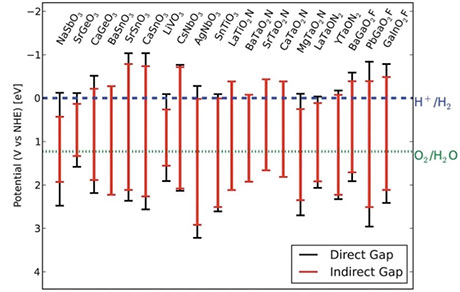Atomic-scale materials design
In the group we work on developing methodology for the design of materials at the atomic scale and we apply the techniques on a variety of problems some of them related to energy materials.
The methodology activities include:
- Development of the Atomic Simulation Environment (ASE)[1] to setup and control atomic-scale simulations
- Development of the 1DFT and many-body code GPAW[2,3]. Recently the calculation of the linear density response function[4] and the Bethe-Salpeter equations[5] were implemented.
- Development of the Computational Materials Repository[6] for handling and sharing large amounts of data.
- Development of new exchange-correlation functionals using machine-learning techniques. The functionals include van der Waals interactions and provide Bayesian error estimation[7-9].
In the area of materials screening and design we have recently focused on finding light harvesting materials for photoinduced water splitting. We have in particular investigated stability and bandgaps of oxides, oxynitrides, oxysulfides, oxyfluorides, and oxyfluoronitrides in the perovskite structure, and have identified a number of candidate materials for both one- and two-photon (tandem) water-splitting[10,11]. The data for the 20000 materials are available in our CMR database[6] and different genetic search strategies have been studied[12]. The investigations have recently been extended to double and layered perovskites[13,14] where we address the issue of bandgap engineering in these materials. In collaboration with the Materials Project in the US we are now performing a broader screening of already known materials within the ICSD database. The screening work is illustrated by the figure showing the calculated bandgaps for the discovered candidate materials for one-photon water splitting[10]. Some of the candidate materials are now under experimental investigation at CINF.

| [1] | S. R. Bahn and K. W. Jacobsen, “An Object-Oriented Scripting Interface to a Legacy Electronic Structure Code,” Computing in Science and Engineering 4(3), 56–66 (2002). |
| [2] | J. J. Mortensen, L. B. Hansen, and K. W. Jacobsen, “Real-space grid implementation of the projector augmented wave method,” Phys. Rev. B 71(3), 35109 (2005) [doi:10.1103/PhysRevB.71.035109]. |
| [3] | J. Enkovaara, C. Rostgaard, J. J. Mortensen, J. Chen, M. Dułak, L. Ferrighi, J. Gavnholt, C. Glinsvad, V. Haikola, et al., “Electronic structure calculations with GPAW: a real-space implementation of the projector augmented-wave method,” Journal of Physics Condensed Matter 22(2), 3202 (2010) [doi:10.1088/0953-8984/22/25/253202]. |
| [4] | J. Yan, J. J. Mortensen, K. W. Jacobsen, and K. S. Thygesen, “Linear density response function in the projector augmented wave method: Applications to solids, surfaces, and interfaces,” Phys. Rev. B {83}({24}), 245122 (2011) [doi:{10.1103/PhysRevB.83.245122}]. |
| [5] | J. Yan, K. W. Jacobsen, and K. S. Thygesen, “Optical properties of bulk semiconductors and graphene/boron nitride: The Bethe-Salpeter equation with derivative discontinuity-corrected density functional energies,” Phys. Rev. B 86(4), 45208 (2012) [doi:10.1103/PhysRevB.86.045208]. |
| [6] | D. D. Landis, J. S. Hummelshøj, S. Nestorov, J. Greeley, M. Dulak, T. Bligaard, J. K. Nørskov, and K. W. Jacobsen, “The Computational Materials Repository,” Computing in Science and Engineering 14(6), 51–57 (2012) [doi:10.1109/MCSE.2012.16]. |
| [7] | J. J. Mortensen, K. Kaasbjerg, S. L. Frederiksen, J. K. Nørskov, J. P. Sethna, and K. W. Jacobsen, “Bayesian Error Estimation in Density-Functional Theory,” Phys. Rev. Lett. 95(2), 216401–216404 (2005) [doi:10.1103/PhysRevLett.95.216401]. |
| [8] | V. Petzold, T. Bligaard, and K. W. Jacobsen, “Construction of New Electronic Density Functionals with Error Estimation Through Fitting,” Topics in Catalysis 55(5-6), 402–417 (2012) [doi:10.1007/s11244-012-9801-7]. |
| [9] | J. Wellendorff, K. T. Lundgaard, A. Møgelhøj, V. Petzold, D. D. Landis, J. K. Nørskov, T. Bligaard, and K. W. Jacobsen, “Density functionals for surface science: Exchange-correlation model development with Bayesian error estimation,” Phys. Rev. B 85(2), 235149 (2012) [doi:10.1103/PhysRevB.85.235149]. |
| [10] | I. E. Castelli, T. Olsen, S. Datta, D. D. Landis, S. Dahl, K. S. Thygesen, and K. W. Jacobsen, “Computational screening of perovskite metal oxides for optimal solar light capture,” Energy Environ. Sci. 5(2), 5814 (2012) [doi:10.1039/c1ee02717d]. |
| [11] | I. E. Castelli, D. D. Landis, K. S. Thygesen, S. Dahl, I. Chorkendorff, T. F. Jaramillo, and K. W. Jacobsen, “New cubic perovskites for one- and two-photon water splitting using the computational materials repository,” Energy Environ. Sci. 5(10), 9034 (2012) [doi:10.1039/c2ee22341d]. |
| [12] | A. Jain, I. E. Castelli, G. Hautier, D. H. Bailey, and K. W. Jacobsen, “Performance of genetic algorithms in search for water splitting perovskites,” Journal of Materials Science 48, 6519–6534 (2013) [doi:10.1007/s10853-013-7448-9]. |
| [13] | I. E. Castelli, K. S. Thygesen, and K. W. Jacobsen, “Bandgap Engineering of Double Perovskites for One- and Two-photon Water Splitting,” presented at MRS Proceedings, 22 March 2013, mrsf12–1523–qq07–06 [doi:10.1557/opl.2013.450]. |
| [14] | I. E. Castelli, J. M. Garcia-Lastra, F. Hüser, K. S. Thygesen, and K. W. Jacobsen, “Stability and bandgaps of layered perovskites for one- and two-photon water splitting,” New Journal Of Physics 15(10), 105026 (2013) [doi:10.1088/1367-2630/15/10/105026]. |